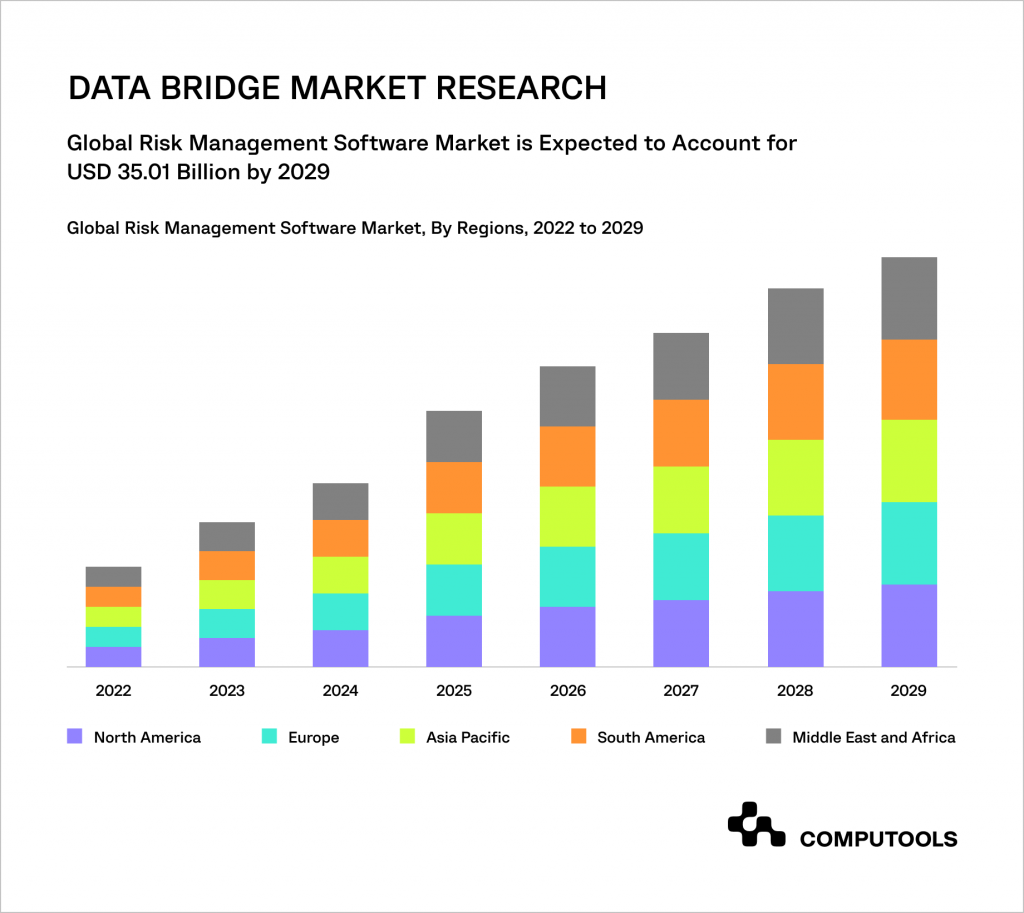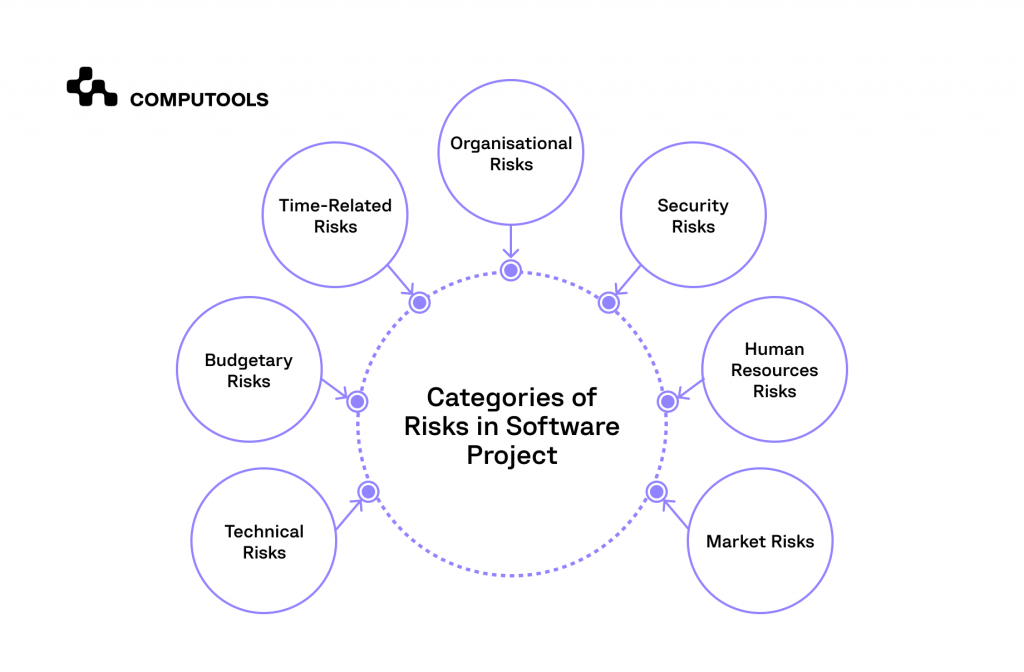Within the realm of Software Engineering, businesses must strike the right balance between creativity and organisation as they navigate through different development stages such as brainstorming, market analysis, coding, prototyping, testing and product deployment. Each step demands considerable effort and comes with its own set of challenges.
Successful projects always have a solid plan for Software Engineering risks mitigation. In this article, we will break down different risk categories and provide practical insights to help business owners create an effective strategy for managing risks and choosing a reliable vendor for their development projects.
Understanding Global Market Challenges
As online threats continue to escalate, the concerns about Software Engineering risks have intensified, drawing the attention of businesses of various sizes, from small and medium-sized enterprises to larger corporations. According to projections by Data Bridge Market Research, the market for risk management software is anticipated to reach an impressive $35.01 billion by 2029.
Software development problems can be categorised into seven main areas: technical, budgetary, time-related, organisational, security, human resources and market risks. Each category poses significant potential impacts on the outcomes of a project and the overall quality of the final product.
Security-related risks are particularly noteworthy, given their high danger level and prevalence, especially in the context of the increasing incidents of cybercrimes. A report by Statista highlights that in the United Kingdom in 2023, the average cost of a major cybersecurity breach was £1,100 for businesses, with larger businesses incurring proportionally higher costs.
It is crucial to understand that the repercussions of a cyberattack extend beyond financial losses, as companies also invest considerable time in recovery efforts.
Apart from cybersecurity, organisational issues are another significant risk category. These issues affect businesses of all sizes and can lead to project failures. Factors contributing to these failures include over-reliance on key individuals, inaccurate work estimations and communication breakdowns that lead to misunderstandings, as noted in a survey by the ICT Institute.
To help businesses mitigate custom Software Engineering risks, we have compiled a list of common challenges in Software Engineering, along with practical Software Engineering strategies for minimising these risks.

Top Software Development Risks and How To Mitigate Them
Every project comes with its share of risks and this is particularly true in the technology field. Achieving growth and profitability always requires informed decisions and reliance on time-proven solutions. The following points highlight the main Software Engineering risks that need attention.

1. Technical risks
Technical risks relate to issues that affect the software’s functionality and performance. These risks can arise from various factors, including hardware limitations or system vulnerabilities. Technical risks often result in software that does not meet the desired standards or user requirements.
Common sources of technical risks include:
• Incompatibility with existing systems
• Software bugs and glitches
• Inadequate technical resources or tools
• Technology obsolescence
• Unproven technologies failing to meet project requirements
Solutions: To successfully mitigate custom Software Engineering risks, project managers and development teams should adopt a well-rounded and proactive approach from the project’s beginning.
• Assemble a team with the right mix of skills and experience.
• Conduct early discussions with stakeholders to understand their needs and expectations.
• Ensure that the technical requirements of the project are clearly outlined.
• Establish strong QA practices, including systematic code reviews and various stages of testing.
• Continually train and mentor the development team to keep them updated with the latest technological trends.
• Start with a minimum viable product (MVP) to test key concepts and gather initial feedback.
2. Budgetary risks
Budgetary risks in Software Engineering stem from the financial challenges faced during the development process. These risks are often due to unforeseen expenses, underestimation of costs, or financial mismanagement. Budgetary constraints can hugely impact the scope and quality of a project.
Typical causes of budgetary risks include:
• Cost overruns due to scope creep
• Underestimating the financial resources required
• Unexpected expenses or financial constraints
• Fluctuating costs of technology or resources
• Inaccurate cost estimation in the project planning phase
Solutions: Project managers should closely monitor the overall financial health of their projects.
• Create a detailed budget that includes extra funds for unexpected costs.
• Regularly monitor and review expenditures against the budget.
• Employ project management tools for better financial oversight.
• Engage in effective scope management to avoid scope creep.
• Conduct frequent financial reviews and adjust plans as necessary.
3. Time-related risks
Time management is a critical factor in Software Engineering, where deadlines dictate the pace. Project delays affect market opportunities and escalate costs. Conversely, hastening development might compromise quality. Time-related risks are primarily a result of poor planning and unrealistic scheduling.
Factors contributing to these risks include:
• Delays in project milestones
• Underestimating the time required for tasks
• Dependency delays (e.g. waiting for external vendors or resources)
• Time management issues within the development team
• Changes in project scope leading to extended timelines
Solutions: Project leaders should closely monitor each step of their project’s timeline to guarantee it stays on track.
• Create a detailed and realistic schedule, including extra time for unexpected delays.
• Ensure each phase of development has enough allocated time so no part is hurried.
• Determine the most important tasks and consider assigning less critical ones to external professionals.
• Use Agile methodologies for better efficiency.
• Regularly check the project’s timeline and make necessary adjustments.
4. Organisational risks
Organisational software projects risks are linked to the internal processes and everyday activities of a project. These risks arise from inadequate or failed internal procedures, systems, or policies. Organisational challenges can disrupt the smooth running of the project and affect its overall success.
Influences on organisational risks include:
• Changes in company policy or strategy
• Internal politics or conflicts within the team
• Lack of clear leadership or decision-making processes
• Inefficient project management practices
• Organisational restructuring during the project lifecycle
• Poor training or onboarding processes
Solutions: Implement these measures to safeguard against the pitfalls of ineffective project management and communication breakdowns.
• Promote team collaboration and communication using tools like Slack, Microsoft Teams, etc.
• Implement project management software to monitor progress, organise tasks and resources and create detailed reports.
• Hold regular meetings with your team and stakeholders for updates.
• Make sure every team member knows their specific roles and responsibilities.
5. Security risks
In an era of increasing digital threats, Software Engineering is particularly vulnerable to security risks. These risks include a range of issues, from data breaches to unauthorised access, potentially causing severe damage. Security in Software Engineering is a huge concern, with risks originating from multiple sources.
Key factors leading to security risks include:
• Vulnerabilities to cyberattacks or data breaches
• Inadequate security measures in software design
• Lack of compliance with security standards and regulations
• Insider threats or human error leading to security lapses
• Failure to regularly update and patch software
Solutions: Every business should place a strong emphasis on security at every stage of the Software Engineering lifecycle.
• Regularly schedule and perform thorough security assessments and testing.
• Use robust encryption techniques and security protocols.
• Ensure continuous education and awareness for all employees about cybersecurity.
• Stay informed about the best cyber defence practices.
6. Human resources risks
The human element in Software Engineering projects plays a key role. Challenges such as skill gaps, team dynamics and staff turnover can significantly impact the project’s progress and outcome. Human resource risks are multifaceted, often involving aspects of skill alignment and communications models in IT projects.
Common sources of human resource risks include:
• Staff turnover or key personnel leaving the project
• Inadequate skills or training of team members
• Miscommunication or lack of collaboration among team members
• Burnout or reduced productivity due to overwork
• Resistance to change affecting the adoption of new technologies
Solutions: Understanding that changes in team members can quickly disrupt a project, it’s important to maintain a stable team to ensure the project’s success.
• Have a plan in place for back-up staff who can step in when needed
• Consider hiring freelancers, outsourcing certain tasks or having dedicated teams ready so you can adjust your workforce as needed.
• Keep detailed records so that when someone leaves the project, their replacement can easily pick up where they left off.
• Set up a system where experienced team members mentor others.
7. Market risks
Market risks describe external factors that impact the project’s success. These risks are often unpredictable and stem from market trends, consumer preferences or economic shifts.
Typical causes of market risks include:
• Competitive pressures or new entrants into the market
• Economic downturns affecting market stability
• Legal or regulatory changes impacting the product
• Technological advancements rendering the project obsolete
Solutions: While it’s true that many market risks are beyond our control, this doesn’t mean businesses are powerless in the face of them.
• Continually monitor and analyse market trends as well as shifts in regulations and compliance requirements.
• Cultivate a flexible business strategy that allows for quick adaptation to changing market conditions.
• Develop comprehensive contingency plans to address and manage disruptions arising from external influences.

Computools
Software Solutions
Computools is an IT consulting and software engineering company that delivers innovative solutions to help businesses unlock tomorrow. Our clients represent a wide range of industries, including retail, logistics, finance, healthcare, and others.
Strategic Vendor Choice: Tips for Minimising Risks
The task of handling risks depends on the company’s management and the approach taken by the development team. In the case of collaborating with a custom Software Engineering services company, the responsibility for risk management is shared between the client and the vendor. Here are some recommendations on cooperation with vendors to mitigate risks.
1. In-depth vendor research
Begin by thoroughly investigating the security practices and risk management procedures of potential vendors. One essential step is to request an SOC 2 audit, which provides a comprehensive review of the vendor’s security measures. By conducting this detailed research upfront, you can ensure that the vendor’s security standards align with yours.
For example, Computools holds certifications in ISO 27001 and ISO 9001:2015, indicating a focus on high-quality standards in critical areas. These certifications highlight our approach to integrating security and quality management systems, aiming for responsible and reliable partnerships and ensuring that our practices align with internationally recognised standards.
2. Prioritising clear communication
Clear and consistent communication is key to the success of any project, especially in managing risks. Regularly organise meetings to update your vendor on risk management status, discuss any new or changing risks and assign related tasks. Maintaining open lines of communication helps build a collaborative environment where everyone is involved in risk reduction.
3. Leveraging vendor expertise
Vendors who are deeply knowledgeable in specific technologies and areas can anticipate and effectively manage complex challenges in a project, greatly reducing the likelihood of technical issues.
In sectors where compliance and security are paramount, the value of a vendor’s subject matter expertise is especially significant. These vendors ensure that the software meets all legal and security requirements, thereby minimising the risks related to legal compliance and data security.
4. Risk management in early planning
Since risks can arise at any stage of the project, incorporating risk management strategies early on allows for more efficient handling of potential issues.
At Computools, our project management process begins with clear definitions of project scope, deliverables, timelines and potential risks. Project managers set up effective communication to keep teams well-informed and supported.
To organise tasks, we allocate resources and monitor progress, using established project management methodologies like Agile and Scrum. These practices are designed to minimise risks and contribute to the successful completion of Software Engineering projects.
By making risk management a fundamental part of our project plan from the start, we can identify and address risks early, avoiding the need to react to problems after they have already occurred.
Conclusion
Starting a project involves facing various Software Engineering issues, such as unclear project requirements, limited resources, external vulnerabilities and complex relationships with stakeholders, as we discussed earlier.
However, the key to successful Software Engineering lies in effectively managing these challenges through proactive risk management. By anticipating potential problems and preparing to address them, you can navigate the changing landscape of innovation with greater confidence and efficiency.
If you’re facing a specific challenge in your business and need a custom solution, we’re here to assist. Feel free to get in touch with us at info@computools.com for a free consultation on Software Engineering.









“Computools was selected through an RFP process. They were shortlisted and selected from between 5 other suppliers. Computools has worked thoroughly and timely to solve all security issues and launch as agreed. Their expertise is impressive.”